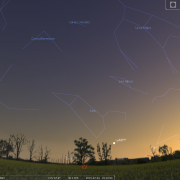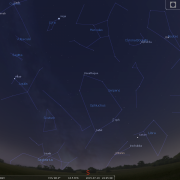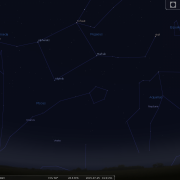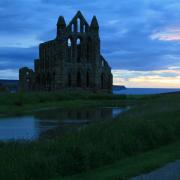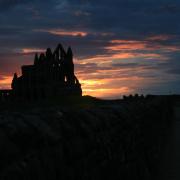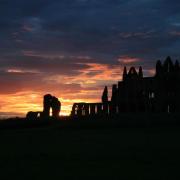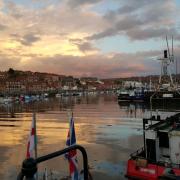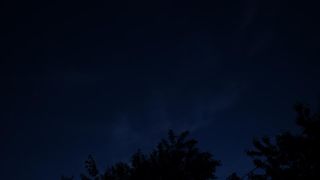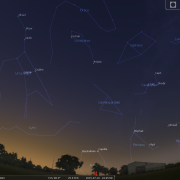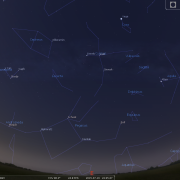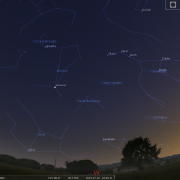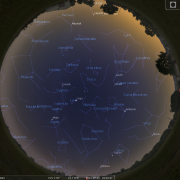In this month's Sky Notes:
Planetary Skylights

 Venus and Jupiter remain extremely close to each other at the start of July, appearing in the same field of view at low telescopic magnification. Venus, by far the brighter, will exhibit a distinct waning quarter phase. Jupiter will have its attendant Galilean moons close by (on the 1st Gamymede, Europa and Io will be on one side with Callisto very close to Jupiter on the other). On the 18th a slim crescent moon lies lower right of Venus. From mid-month onwards both planets become increasingly challenging to spot and are pretty much lost in twilight by the month's end.
Venus and Jupiter remain extremely close to each other at the start of July, appearing in the same field of view at low telescopic magnification. Venus, by far the brighter, will exhibit a distinct waning quarter phase. Jupiter will have its attendant Galilean moons close by (on the 1st Gamymede, Europa and Io will be on one side with Callisto very close to Jupiter on the other). On the 18th a slim crescent moon lies lower right of Venus. From mid-month onwards both planets become increasingly challenging to spot and are pretty much lost in twilight by the month's end.
 Saturn is visible low to the south, slowly moving backwards through Libra. A telescope is required to resolve the glorious ring system, which is orientated at its widest. The moon lies nearby on the 25th and 26th. Titan, Saturn’s largest moon will be visible on the eastern side of the planet on both nights.
Saturn is visible low to the south, slowly moving backwards through Libra. A telescope is required to resolve the glorious ring system, which is orientated at its widest. The moon lies nearby on the 25th and 26th. Titan, Saturn’s largest moon will be visible on the eastern side of the planet on both nights.

 The outer gas worlds of Uranus and Neptune are visible in the early morning hours in Pisces and Aquarius respectively. Earth is at Aphelion (furthest from Sun) on July 4th, a distance of around 95 million miles (152 million km)
The outer gas worlds of Uranus and Neptune are visible in the early morning hours in Pisces and Aquarius respectively. Earth is at Aphelion (furthest from Sun) on July 4th, a distance of around 95 million miles (152 million km)
Meteor Activity

The weak Ophiuchid meteor shower has two maxima, June 9th and June 20th. The zenith hourly rate (ZHR) barely exceeds sporadic levels (5 - 8 per hr) Observe post midnight. The poorly observed June Lyrids peak on the 15th/16th, again the ZHR is only 5-6 per hour.
Summer Solstice in Whitby
Summer Solstice photos submitted by WDAS Members. Click thumbnail for full-sized image.
|
Whitby Abbey on 21-Jun-2015
around 21:30h, taken by Mark. |
Whitby Abbey on 21-Jun-2015 |
|
Whitby Abbey on 21-Jun-2015
around 21:30h, taken by Mark. |
Whitby Harbour taken by Warren.
(Not exactly on Summer Solstice, but it's a fabulous photo!) |
A series of coronal mass ejection's (CMEs) hit Earth's magnetic field in the early morning hours of June 22nd, producing a severe G4-class geomagnetic storm and giving rise to quite a display of aurora (northern or southern lights).
Unfortunately much of the UK was clouded out and we missed out on the East coast. A second predicted display over the night of the 24/25th failed to live up to expectations, apparently taking place during daylight hours.
If you've sat out during the midnight hours of Summer twilight on Whitby's West Cliff looking for a hint of Aurora, you may wonder what you're hoping to recognise. This image taken by Martin McKenna is what you may see.
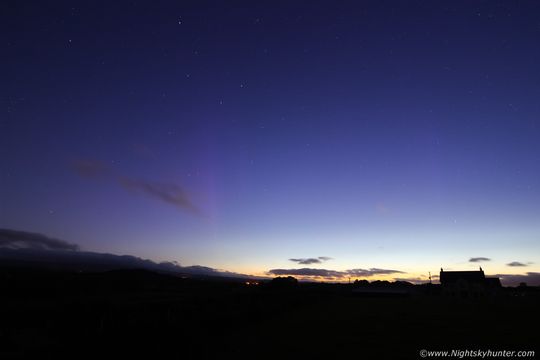
Aurora in Maghera, Northern Ireland on 22/23-Jun-2015 Captured by
Martin McKenna. Several purple rays over 40 degrees high can be seen to the left of centre
and above the house. (See Martin's photos at nightskyhunter.com). Click for full-sized image.
And here is Aurora captured in Wales by Huw James with a 15 second exposure.
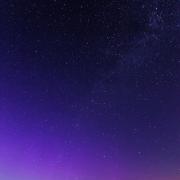
Aurora under Milky Way
Huw James 22-Jun-2015
Click for full-sized image.
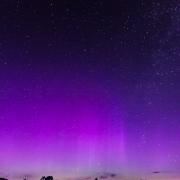
Aurora under Polaris
Huw James 22-Jun-2015
Click for full-sized image.
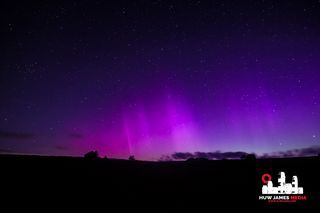
Aurora in the Brecon Beacons on 23-Jun-2015
Although Whitby was clouded out, Huw James captured
some amazing images (15s exposure). This one under
Ursa Major. (See Huw's photos on Flickr)
Click for full-sized image.
Now you know what you're looking for, see if you can pick out a hint of Aurora in Mark's photo.
Possible Aurora sighting, Whitby on 25-Jun-2105
This was two days after the big display captured
elsewhere in the UK. "Jury's out on this one", said
Mark. Click for full-sized image.
Even though we were unlucky in Whitby, as solar activity is quite high at present it is worth keeping a watchful eye on the sky and the Web, as further displays may be on the cards.
Useful link: Lancashire University Aurora Watch
Early/mid July is the optimum time in which a display of Noctilucent cloud may be visible. These delicate formations, filamentary in structure and having a characteristic silvery-blue colour, appear in the twilight sky above the northern horizon, long after sunset, even after midnight.
It forms almost exclusively between latitudes 50 and 60 degrees north, high in the upper atmosphere: 50 miles up- five times higher than normal clouds. The cloud forms when water vapour condenses at the low temperatures that prevail at such altitudes onto particles suspended in the air.
|
Looking South
Mid July - 22:45h |
Looking North |
|
Looking East
Mid July - 22:45h |
Looking West
Mid July - 22:45h |
|
|
|
|
Overview
Mid July - 22:35h |
|
Additional Image Credits:
- Planets and Comets where not otherwise mentioned: NASA
- Sky Charts: Stellarium Software
- Log in to post comments

